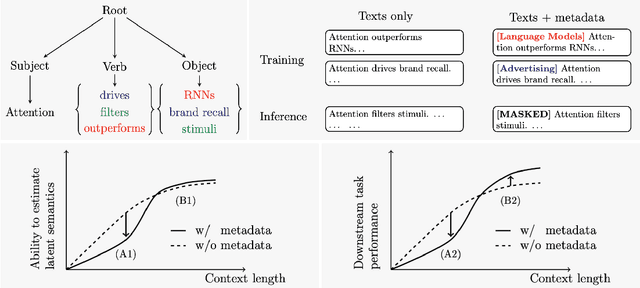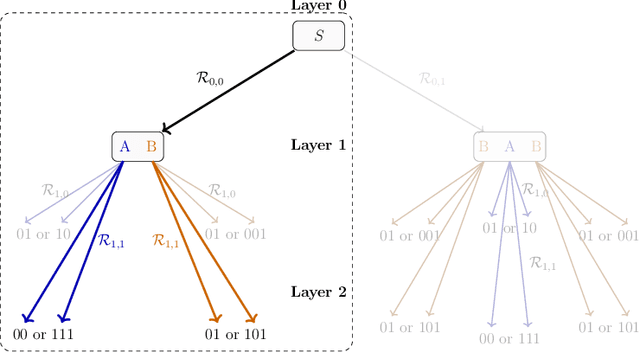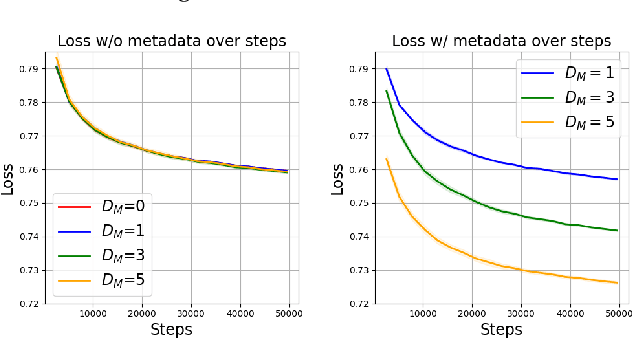Taiji Suzuki
Generalization Bound of Gradient Flow through Training Trajectory and Data-dependent Kernel
Jun 12, 2025Abstract:Gradient-based optimization methods have shown remarkable empirical success, yet their theoretical generalization properties remain only partially understood. In this paper, we establish a generalization bound for gradient flow that aligns with the classical Rademacher complexity bounds for kernel methods-specifically those based on the RKHS norm and kernel trace-through a data-dependent kernel called the loss path kernel (LPK). Unlike static kernels such as NTK, the LPK captures the entire training trajectory, adapting to both data and optimization dynamics, leading to tighter and more informative generalization guarantees. Moreover, the bound highlights how the norm of the training loss gradients along the optimization trajectory influences the final generalization performance. The key technical ingredients in our proof combine stability analysis of gradient flow with uniform convergence via Rademacher complexity. Our bound recovers existing kernel regression bounds for overparameterized neural networks and shows the feature learning capability of neural networks compared to kernel methods. Numerical experiments on real-world datasets validate that our bounds correlate well with the true generalization gap.
On the Role of Label Noise in the Feature Learning Process
May 25, 2025Abstract:Deep learning with noisy labels presents significant challenges. In this work, we theoretically characterize the role of label noise from a feature learning perspective. Specifically, we consider a signal-noise data distribution, where each sample comprises a label-dependent signal and label-independent noise, and rigorously analyze the training dynamics of a two-layer convolutional neural network under this data setup, along with the presence of label noise. Our analysis identifies two key stages. In Stage I, the model perfectly fits all the clean samples (i.e., samples without label noise) while ignoring the noisy ones (i.e., samples with noisy labels). During this stage, the model learns the signal from the clean samples, which generalizes well on unseen data. In Stage II, as the training loss converges, the gradient in the direction of noise surpasses that of the signal, leading to overfitting on noisy samples. Eventually, the model memorizes the noise present in the noisy samples and degrades its generalization ability. Furthermore, our analysis provides a theoretical basis for two widely used techniques for tackling label noise: early stopping and sample selection. Experiments on both synthetic and real-world setups validate our theory.
Direct Density Ratio Optimization: A Statistically Consistent Approach to Aligning Large Language Models
May 12, 2025Abstract:Aligning large language models (LLMs) with human preferences is crucial for safe deployment, yet existing methods assume specific preference models like Bradley-Terry model. This assumption leads to statistical inconsistency, where more data doesn't guarantee convergence to true human preferences. To address this critical gap, we introduce a novel alignment method Direct Density Ratio Optimization (DDRO). DDRO directly estimates the density ratio between preferred and unpreferred output distributions, circumventing the need for explicit human preference modeling. We theoretically prove that DDRO is statistically consistent, ensuring convergence to the true preferred distribution as the data size grows, regardless of the underlying preference structure. Experiments demonstrate that DDRO achieves superior performance compared to existing methods on many major benchmarks. DDRO unlocks the potential for truly data-driven alignment, paving the way for more reliable and human-aligned LLMs.
Quantifying Memory Utilization with Effective State-Size
Apr 28, 2025Abstract:The need to develop a general framework for architecture analysis is becoming increasingly important, given the expanding design space of sequence models. To this end, we draw insights from classical signal processing and control theory, to develop a quantitative measure of \textit{memory utilization}: the internal mechanisms through which a model stores past information to produce future outputs. This metric, which we call \textbf{\textit{effective state-size}} (ESS), is tailored to the fundamental class of systems with \textit{input-invariant} and \textit{input-varying linear operators}, encompassing a variety of computational units such as variants of attention, convolutions, and recurrences. Unlike prior work on memory utilization, which either relies on raw operator visualizations (e.g. attention maps), or simply the total \textit{memory capacity} (i.e. cache size) of a model, our metrics provide highly interpretable and actionable measurements. In particular, we show how ESS can be leveraged to improve initialization strategies, inform novel regularizers and advance the performance-efficiency frontier through model distillation. Furthermore, we demonstrate that the effect of context delimiters (such as end-of-speech tokens) on ESS highlights cross-architectural differences in how large language models utilize their available memory to recall information. Overall, we find that ESS provides valuable insights into the dynamics that dictate memory utilization, enabling the design of more efficient and effective sequence models.
When Does Metadata Conditioning (NOT) Work for Language Model Pre-Training? A Study with Context-Free Grammars
Apr 24, 2025



Abstract:The ability to acquire latent semantics is one of the key properties that determines the performance of language models. One convenient approach to invoke this ability is to prepend metadata (e.g. URLs, domains, and styles) at the beginning of texts in the pre-training data, making it easier for the model to access latent semantics before observing the entire text. Previous studies have reported that this technique actually improves the performance of trained models in downstream tasks; however, this improvement has been observed only in specific downstream tasks, without consistent enhancement in average next-token prediction loss. To understand this phenomenon, we closely investigate how prepending metadata during pre-training affects model performance by examining its behavior using artificial data. Interestingly, we found that this approach produces both positive and negative effects on the downstream tasks. We demonstrate that the effectiveness of the approach depends on whether latent semantics can be inferred from the downstream task's prompt. Specifically, through investigations using data generated by probabilistic context-free grammars, we show that training with metadata helps improve model's performance when the given context is long enough to infer the latent semantics. In contrast, the technique negatively impacts performance when the context lacks the necessary information to make an accurate posterior inference.
Propagation of Chaos for Mean-Field Langevin Dynamics and its Application to Model Ensemble
Feb 09, 2025Abstract:Mean-field Langevin dynamics (MFLD) is an optimization method derived by taking the mean-field limit of noisy gradient descent for two-layer neural networks in the mean-field regime. Recently, the propagation of chaos (PoC) for MFLD has gained attention as it provides a quantitative characterization of the optimization complexity in terms of the number of particles and iterations. A remarkable progress by Chen et al. (2022) showed that the approximation error due to finite particles remains uniform in time and diminishes as the number of particles increases. In this paper, by refining the defective log-Sobolev inequality -- a key result from that earlier work -- under the neural network training setting, we establish an improved PoC result for MFLD, which removes the exponential dependence on the regularization coefficient from the particle approximation term of the optimization complexity. As an application, we propose a PoC-based model ensemble strategy with theoretical guarantees.
Direct Distributional Optimization for Provable Alignment of Diffusion Models
Feb 05, 2025



Abstract:We introduce a novel alignment method for diffusion models from distribution optimization perspectives while providing rigorous convergence guarantees. We first formulate the problem as a generic regularized loss minimization over probability distributions and directly optimize the distribution using the Dual Averaging method. Next, we enable sampling from the learned distribution by approximating its score function via Doob's $h$-transform technique. The proposed framework is supported by rigorous convergence guarantees and an end-to-end bound on the sampling error, which imply that when the original distribution's score is known accurately, the complexity of sampling from shifted distributions is independent of isoperimetric conditions. This framework is broadly applicable to general distribution optimization problems, including alignment tasks in Reinforcement Learning with Human Feedback (RLHF), Direct Preference Optimization (DPO), and Kahneman-Tversky Optimization (KTO). We empirically validate its performance on synthetic and image datasets using the DPO objective.
Metastable Dynamics of Chain-of-Thought Reasoning: Provable Benefits of Search, RL and Distillation
Feb 02, 2025Abstract:A key paradigm to improve the reasoning capabilities of large language models (LLMs) is to allocate more inference-time compute to search against a verifier or reward model. This process can then be utilized to refine the pretrained model or distill its reasoning patterns into more efficient models. In this paper, we study inference-time compute by viewing chain-of-thought (CoT) generation as a metastable Markov process: easy reasoning steps (e.g., algebraic manipulations) form densely connected clusters, while hard reasoning steps (e.g., applying a relevant theorem) create sparse, low-probability edges between clusters, leading to phase transitions at longer timescales. Under this framework, we prove that implementing a search protocol that rewards sparse edges improves CoT by decreasing the expected number of steps to reach different clusters. In contrast, we establish a limit on reasoning capability when the model is restricted to local information of the pretrained graph. We also show that the information gained by search can be utilized to obtain a better reasoning model: (1) the pretrained model can be directly finetuned to favor sparse edges via policy gradient methods, and moreover (2) a compressed metastable representation of the reasoning dynamics can be distilled into a smaller, more efficient model.
Optimality and Adaptivity of Deep Neural Features for Instrumental Variable Regression
Jan 09, 2025

Abstract:We provide a convergence analysis of deep feature instrumental variable (DFIV) regression (Xu et al., 2021), a nonparametric approach to IV regression using data-adaptive features learned by deep neural networks in two stages. We prove that the DFIV algorithm achieves the minimax optimal learning rate when the target structural function lies in a Besov space. This is shown under standard nonparametric IV assumptions, and an additional smoothness assumption on the regularity of the conditional distribution of the covariate given the instrument, which controls the difficulty of Stage 1. We further demonstrate that DFIV, as a data-adaptive algorithm, is superior to fixed-feature (kernel or sieve) IV methods in two ways. First, when the target function possesses low spatial homogeneity (i.e., it has both smooth and spiky/discontinuous regions), DFIV still achieves the optimal rate, while fixed-feature methods are shown to be strictly suboptimal. Second, comparing with kernel-based two-stage regression estimators, DFIV is provably more data efficient in the Stage 1 samples.
On the Comparison between Multi-modal and Single-modal Contrastive Learning
Nov 05, 2024

Abstract:Multi-modal contrastive learning with language supervision has presented a paradigm shift in modern machine learning. By pre-training on a web-scale dataset, multi-modal contrastive learning can learn high-quality representations that exhibit impressive robustness and transferability. Despite its empirical success, the theoretical understanding is still in its infancy, especially regarding its comparison with single-modal contrastive learning. In this work, we introduce a feature learning theory framework that provides a theoretical foundation for understanding the differences between multi-modal and single-modal contrastive learning. Based on a data generation model consisting of signal and noise, our analysis is performed on a ReLU network trained with the InfoMax objective function. Through a trajectory-based optimization analysis and generalization characterization on downstream tasks, we identify the critical factor, which is the signal-to-noise ratio (SNR), that impacts the generalizability in downstream tasks of both multi-modal and single-modal contrastive learning. Through the cooperation between the two modalities, multi-modal learning can achieve better feature learning, leading to improvements in performance in downstream tasks compared to single-modal learning. Our analysis provides a unified framework that can characterize the optimization and generalization of both single-modal and multi-modal contrastive learning. Empirical experiments on both synthetic and real-world datasets further consolidate our theoretical findings.
* 51pages, 1 figure, 1 table
 Add to Chrome
Add to Chrome Add to Firefox
Add to Firefox Add to Edge
Add to Edge